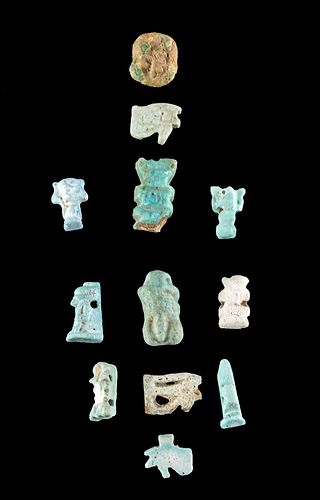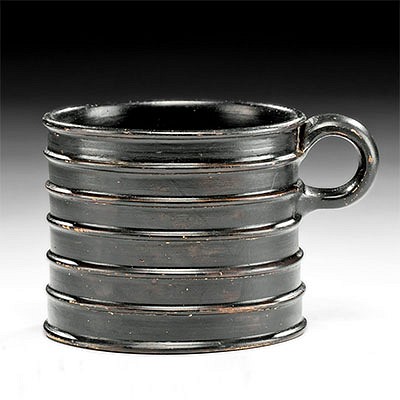Lot of 12 Egyptian Faience Amulets
Lot 10
About Seller
Artemis Fine Arts
686 S Taylor Ave, Ste 106
Louisville, CO 80027
United States
Selling antiquities, ancient and ethnographic art online since 1993, Artemis Gallery specializes in Classical Antiquities (Egyptian, Greek, Roman, Near Eastern), Asian, Pre-Columbian, African / Tribal / Oceanographic art. Our extensive inventory includes pottery, stone, metal, wood, glass and textil...Read more
Categories
Estimate:
$600 - $900
Absentee vs Live bid
Two ways to bid:
- Leave a max absentee bid and the platform will bid on your behalf up to your maximum bid during the live auction.
- Bid live during the auction and your bids will be submitted real-time to the auctioneer.
Bid Increments
| Price | Bid Increment |
|---|---|
| $0 | $25 |
| $300 | $50 |
| $1,000 | $100 |
| $2,000 | $250 |
| $5,000 | $500 |
| $10,000 | $1,000 |
| $20,000 | $2,500 |
| $50,000 | $5,000 |
| $100,000 | $10,000 |
| $200,000 | $20,000 |
About Auction
By Artemis Fine Arts
Mar 12, 2020
Set Reminder
2020-03-12 10:00:00
2020-03-12 10:00:00
America/New_York
Bidsquare
Bidsquare : Ancient / Ethnographic Around The World
https://www.bidsquare.com/auctions/artemis-gallery/ancient-ethnographic-around-the-world-4957
Ancient art from Egypt, Greece, Italy and the Near East, as well as Asian, Fossils, Pre-Columbian, Native American, African / Tribal / Oceanic, Spanish Colonial, Russian Icons, Fine art, much more! Artemis Fine Arts info@artemisfinearts.com
Ancient art from Egypt, Greece, Italy and the Near East, as well as Asian, Fossils, Pre-Columbian, Native American, African / Tribal / Oceanic, Spanish Colonial, Russian Icons, Fine art, much more! Artemis Fine Arts info@artemisfinearts.com
- Lot Description
Egypt, Late Dynastic Period, 26th to 31st Dynasty, ca. 664 to 332 BCE. A fine set of twelve mold-formed faience amulets covered in lustrous blue glaze and all pierced through for suspension. Six of them are Djed pillars. These were commonly placed as an amulet near the spine of a mummy, and the Djed pillar is listed in the Book of the Dead as part of a spell which can be used to reanimate the use of the mummy's spine so that it can sit up, resurrected. It is associated with Osiris, representing his spine, and is one of the oldest symbols in Egyptian mythology. Three others are Eyes of Horus - also known as the Wadjet Eye and the Eye of Ra - a symbol of good health and royal power, personifying the goddess Wadjet, one of the earliest Egyptian deities. Another is a mummiform god, possibly Sobek, the god of the Nile, associated with pharaonic power, fertility, and military prowess, who was often invoked for protection against the dangers of the Nile River. Size of one (largest): 0.75" H (1.9 cm)
A single one is a uadj (papyrus) stem amulet, also a very old motif, that shows a single stalk and umbel of the plant, which grew along the Nile Delta, and was a symbol representing growth, youth, and the production of food. Finally, the last one is round, with a relief image that may be an ankh, but is very difficult to discern due to iridescent deposits on its surface.
Provenance: private Dunn collection, Coral Springs, Florida, USA, acquired in the 1990s
All items legal to buy/sell under U.S. Statute covering cultural patrimony Code 2600, CHAPTER 14, and are guaranteed to be as described or your money back.
A Certificate of Authenticity will accompany all winning bids.
We ship worldwide and handle all shipping in-house for your convenience.
#151807All have wear commensurate with age including light deposits on surface (one has nice iridescence). All are intact. Some of the details have been obscured by natural weathering and depositional processes.Condition
- Shipping Info
-
All shipping is handled in-house for your convenience. Your invoice from Artemis Gallery will include shipping calculation instructions. If in doubt, please inquire BEFORE bidding for estimated shipping costs for individual items.
-
- Buyer's Premium



 EUR
EUR CAD
CAD AUD
AUD GBP
GBP MXN
MXN HKD
HKD CNY
CNY MYR
MYR SEK
SEK SGD
SGD CHF
CHF THB
THB














